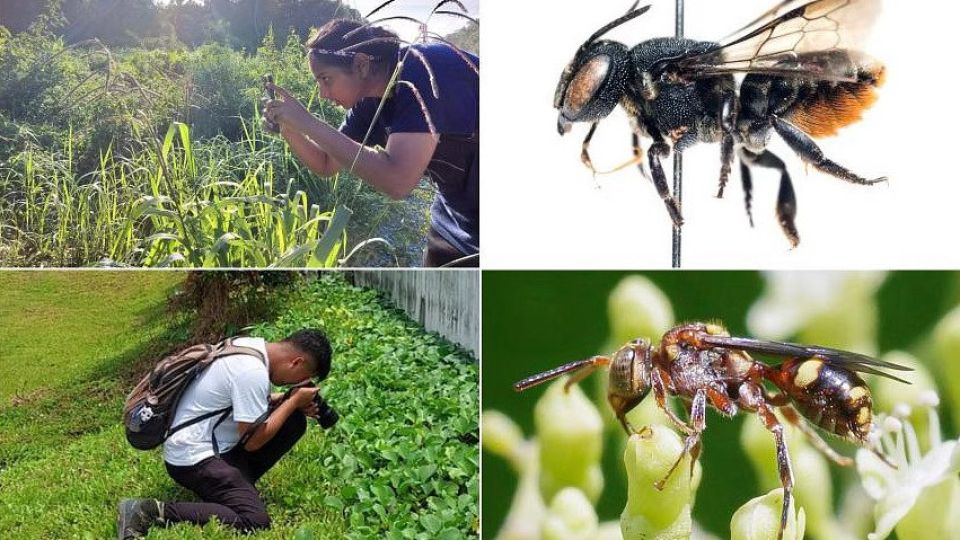November 7, 2023
SINGAPORE – While working at the Sungei Buloh Wetland Reserve’s visitor centre in 2021, Ms Girinandhini Govindharaju found a dead black bee lying on a dusty tripod.
The species looked unfamiliar to Ms Girinandhini, who was on a three-year contract with the National Parks Board (NParks) then. After consulting bee expert and NParks deputy director Zestin Soh, she learnt it was a female Buttel-Reepen’s resin bee, not recorded in Singapore before. A male version of the resin bee was last sighted in 2012.
While bee-watching in Pulau Ubin in 2022, Mr Lim Yu Jun spotted a red and orange stinger foraging at a flowering plant. He took a picture of it and later learnt it was a singed nomad bee after showing it to experts here. This bee species had also never been recorded in Singapore before.
“I was really shocked and excited when I was told it was a new nomad species for Singapore as this (category) of bees is really rare, and on top of that, I came across a new one,” said Mr Lim, 22, who is currently in national service.
Both Ms Girinandhini, 24, and Mr Lim are not formally trained in the study of insects, but with passion for bees and wildlife photography, they helped to add two more species of bees to Singapore’s records.
They are among a growing number of citizen scientists who help to complement the work of a handful of bee experts here to advance bee research in Singapore.
The number of citizen scientists working on different types of fauna in Singapore has grown from 400 in 2015 to over 11,000 in 2023, said NParks. It runs a programme called Community in Nature (CIN) Biodiversity Watch, where members of the public and students join large-scale biodiversity surveys.
“Community scientists tend to go to more different places that professional scientists don’t go to. They go there a lot to monitor and observe, and fill in a lot of data points,” said Assistant Professor John Ascher, an entomologist specialising in bees and wasps from the National University of Singapore’s (NUS) Department of Biological Sciences.
There are about 140 species of bees in Singapore.
Much of citizen scientists’ bee and wasp sightings are logged in iNaturalist, the online database for documenting flora and fauna.
On the site, Mr Lim is currently the top contributor of bee sightings in Singapore, while Prof Ascher is the top identifier of bees here, where he dives into old taxonomy books and scours a specimen collection at the NUS Lee Kong Chian Natural History Museum (LKCNHM).
Mr Soh said: “NParks provides training and shares expertise with citizen scientists to identify bees taxonomically, partners with them to conduct surveys on bees and, where relevant, works with them to publish notable findings in research papers.”
He noted that the bee records shared by citizen scientists have also contributed to a better understanding of each species’ conservation status that was published in the recent Singapore Red List, a reference on the country’s biodiversity.
The Republic’s bee citizen science appears to be a silver lining for the state of bee research in Asia, which seems rather bleak, according to a recent paper on the opportunities and challenges for bee knowledge and conservation in the region, of which Prof Ascher is a lead co-author.
The September 2023 opinion paper, published in scientific journal Biological Conservation, stated that the knowledge base for bees is “vanishingly small” in Asia than that of the rest of the world.
Asia has 15 per cent of the world’s known bee species, but those species cover only 1 per cent of global public data on bee specimens.
“Knowledge of the life histories of Asian bee species is lagging still further behind, limiting our ability to develop effective and targeted conservation strategies,” added the paper, which was led by several leaders of the Asian section of the International Union for Conservation of Nature (IUCN) Wild Bee Specialist Group, which was formed in 2020.
Prof Ascher, the Asian region lead of the group, said the opinion paper is one of the first deliverables from the group, and the next thing they hope to achieve is to create a red list of Asian bee species to show theextinction risk of each of the pollinators.
The paper also mentioned that there is “a dramatic deficit in bee experts in Asia”, and one reason is dwindling career incentives to do taxonomy – which refers to the science of naming and classifying living things.
“Bee research addressing things like response to climate change and impacts on food security is potentially high impact both academically and societally, but we cannot get there if we don’t build the necessary infrastructure and support young talent in under-supported foundational fields such as taxonomy,” said Prof Ascher.


